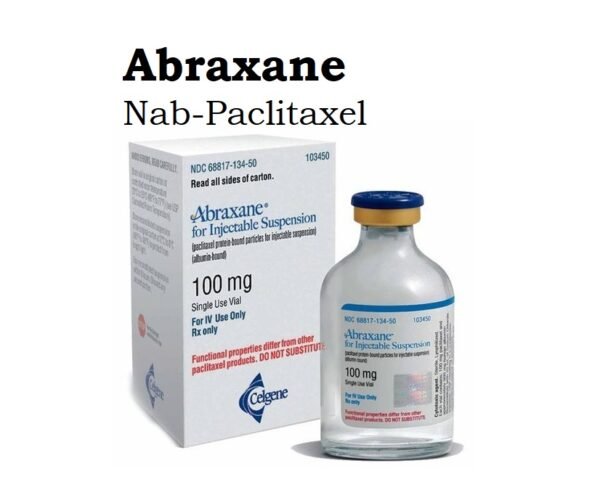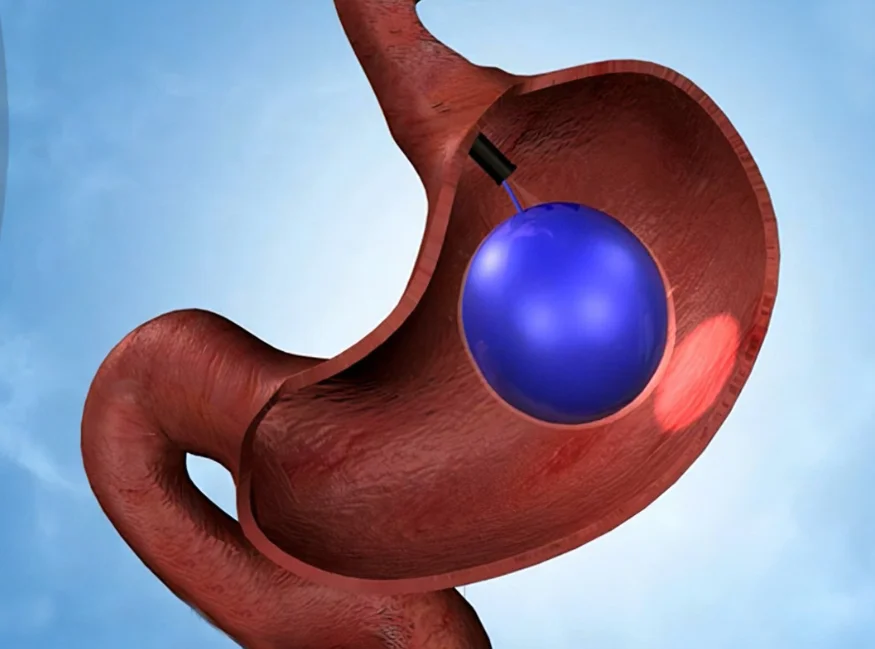Abraxane (Nab-Paclitaxel or nanoparticle albumin-bound paclitaxel) is a chemotherapeutic drug used to treat breast, lung, and ovarian cancers.
Abraxane (Nab-paclitaxel) Uses:
-
Metastatic breast cancer:
- Used for the treatment of breast cancer after failure of combination chemotherapy for metastatic disease or relapse within 6 months of adjuvant chemotherapy; prior therapy should have included an anthracycline unless clinically contraindicated
-
Non-small cell lung cancer:
- Used as first-line treatment of locally advanced or metastatic non-small cell lung cancer (in combination with carboplatin) in patients who are not candidates for curative surgery or radiation therapy
-
Pancreatic adenocarcinoma:
- Used as first-line treatment of metastatic adenocarcinoma of the pancreas (in combination with gemcitabine)
-
Off Label Use of Naboaclitaxel (Abraxane) in Adults:
- metastatic, platinum-resistant bladder cancer
- Advanced, recurrent or persistent cervical cancer
- Metastatic Melanoma
- Recurrent Ovarian, fallopian tube, or primary peritoneal cancers.
Abraxane Dose in Adults
Note:
- When administered as part of a combination chemotherapy regimen, sequence of administration may vary by regimen
- Refer to specific protocols for the sequence of administration.
- Premedication is not generally necessary prior to paclitaxel (protein bound), but maybe required in patients with prior mild to moderate hypersensitivity reactions.
Abraxane Dose in the treatment of metastatic platinum-resistant bladder cancer:
- Intravenous: 260 mg/m² once 3 weekly;
- continue until disease progression or unacceptable toxicity.
Abraxane Dose in the treatment of metastatic Breast cancer:
- Intravenous: 260 mg/m² once 3 weekly.
- Off-label dosing:
- Intravenous: 100 to 150 mg/m² on days 1, 8, and 15 of a 28-day cycle.
Abraxane Dose in the treatment of advanced, recurrent or persistent cervical cancer:
- Intravenous: 125 mg/m² on days 1, 8, and 15 of a 28-day cycle;
- continue until disease progression or unacceptable toxicity.
Abraxane (Nab-paclitaxel) Dose in the treatment of metastatic melanoma:
-
Previously treated patients:
- 100 mg/m² IV on days 1, 8, and 15 of a 28-day cycle;
- if tolerated, the dose may be increased by 25 mg/m² in cycle 2 and beyond.
-
Previously untreated patients:
- 150 mg/m² IV on days 1, 8, and 15 of a 28-day cycle.
Abraxane (Nab-paclitaxel) Dose in the treatment of metastatic or locally advanced Non-small cell lung cancer (NSCLC):
- Intravenous: 100 mg/m² on days 1, 8, and 15 of each 21-day cycle (in combination with carboplatin).
-
Off-label combination:
- 100 mg/m² on days 1, 8, and 15 of each 21-day cycle (in combination with carboplatin and pembrolizumab) for 4 cycles, followed by pembrolizumab maintenance therapy.
Abraxane (Nab-paclitaxel) Dose in the treatment of Recurrent Ovarian, fallopian tube, or primary peritoneal cancer:
- Intravenous: 260 mg/m² on day 1 of a 21-day cycle for 6 to 8 cycles or
- 100 mg/m² on days 1, 8, and 15 of a 28-day cycle until disease progression or unacceptable toxicity.
Abraxane (Nab-paclitaxel) Dose in the treatment of Metastatic Pancreatic adenocarcinoma:
- Intravenous: 125 mg/m² on days 1, 8, and 15 of a 28-day cycle (in combination with gemcitabine).
Abraxane Dose in Childrens
Not indicated in children.
Pregnancy Risk Category: D
- Based on the mechanism and findings from animal reproduction studies, paclitaxel may cause harm to fetuses if given during pregnancy.
- Ex vivo human placenta perfusion model showed that paclitaxel, a non-protein bound preparation, crossed the placenta at terms.
- Placental transfer was low due to the presence of albumin. Higher albumin levels resulted in lower placental paclitaxel transfer.
- A pregnancy test should be done on all females with reproductive potential before treatment is initiated.
- Also, it is important to use effective contraception throughout therapy and for at most six months following the last dose of paclitaxel (protein bound).
- Effective contraception should be used by males who have female partners with reproductive potential during therapy, and at least for three months following the last dose of paclitaxel (protein bound).
Use of Nab-paclitaxel while breastfeeding
- Breast milk secretes paclitaxel (nonprotein bound).
- The manufacturer suggests that breastfeeding mothers refrain from breastfeeding during therapy or for at least 2 weeks after the last dose of paclitaxel (protein bound).
Abraxane (Nab-Paclitaxel) Dose in Kidney Disease:
-
CrCl ≥30 mL/minute:
- Dosage adjustment not necessary
-
CrCl <30 mL/minute:
- No dosage adjustments provided in the manufacturer’s labeling (has not been studied)
-
End-stage renal disease (ESRD):
- No dosage adjustments provided in the manufacturer’s labeling (has not been studied)
Abraxane (Nab-Paclitaxel) Dose in Liver disease:
Abraxane Dosage adjustment for hepatic impairment at treatment initiation:
-
Breast cancer (every 3-week-regimen):
-
Mild impairment (AST ≤10 times ULN and bilirubin >1 to ≤1.5 times ULN):
- Dosage adjustment not necessary.
-
Moderate impairment (AST ≤10 times ULN and bilirubin >1.5 to ≤3 times ULN):
- Reduce dose to 200 mg/m²; may increase up to 260 mg/m² if the reduced dose is tolerated for 2 cycles
-
Severe impairment:
- AST ≤10 times upper limit of normal and bilirubin >3 to ≤5 times upper limit of normal:
- Reduce dose to 200 mg/m²;
- may increase up to 260 mg/m² in subsequent cycles if the reduced dose is tolerated for 2 cycles
-
AST more than 10 times upper limit of normal or bilirubin more 5 times the upper limit of normal:
- Not recommended for use (has not been studied).
- AST ≤10 times upper limit of normal and bilirubin >3 to ≤5 times upper limit of normal:
-
-
Non-small cell lung cancer (NSCLC) regimen:
-
Mild impairment (AST ≤10 times ULN and bilirubin >1 to ≤1.5 times ULN):
- No dosage adjustment is necessary.
-
Moderate impairment (AST ≤10 times ULN and bilirubin >1.5 to ≤3 times ULN):
- Reduce dose to 80 mg/m²; may increase up to 100 mg/m² in subsequent cycles if the reduced dose is tolerated for 2 cycles
-
Severe impairment:
-
AST ≤10 times ULN and bilirubin >3 to ≤5 times ULN:
- Reduce dose to 80 mg/m ; may increase up to 100 mg/m in subsequent cycles if the reduced dose is tolerated for 2 cycles
-
AST >10 times ULN or bilirubin >5 times ULN:
- Use is not recommended (has not been studied).
-
-
-
Pancreatic adenocarcinoma:
-
Mild impairment (AST ≤10 times ULN and bilirubin >1 to ≤1.5 times ULN):
- No dosage adjustment is necessary.
-
Moderate impairment (AST ≤10 times ULN and bilirubin >1.5 to ≤3 times ULN):
- Use is not recommended.
-
Severe impairment:
-
AST ≤10 times ULN and bilirubin >3 to ≤5 times ULN:
- Use is not recommended.
-
AST >10 times ULN or bilirubin >5 times ULN:
- Use is not recommended.
-
Dosage adjustment for hepatic impairment during treatment:
- AST >10 times ULN or bilirubin >5 times ULN: Withhold treatment
-
-
Common Side Effects of Abraxane (Nab-paclitaxel):
-
Cardiovascular:
- ECG Abnormality
- Peripheral Edema
-
Central Nervous System:
- Peripheral Sensory Neuropathy
- Fatigue
- Peripheral Neuropathy
- Headache
- Depression
-
Dermatologic:
- Alopecia
- Skin Rash
-
Endocrine & Metabolic:
- Dehydration
- Increased Gamma-Glutamyl Transferase
- Hypokalemia
-
Gastrointestinal:
- Nausea
- Diarrhea
- Decreased Appetite
- Vomiting
- Constipation
- Dysgeusia
-
Genitourinary:
- Urinary Tract Infection
-
Hematologic & Oncologic:
- Anemia
- Neutropenia
- Thrombocytopenia
- Bone Marrow Depression
-
Hepatic:
- Increased Serum Aspartate Aminotransferase
- Increased Serum Alkaline Phosphatase
-
Infection:
- Infection
-
Neuromuscular & Skeletal:
- Asthenia
- Musculoskeletal Pain
- Limb Pain
-
Ophthalmic:
- Visual Disturbance
-
Renal:
- Increased Serum Creatinine
-
Respiratory:
- Cough
- Epistaxis
- Dyspnea
-
Miscellaneous:
- Fever
Less Common Side Effects Of Abraxane (Nab-paclitaxel):
-
Cardiovascular:
- Edema
- Cardiac Failure
- Hypertension
- Tachycardia
- Hypotension
- Significant Cardiovascular Event
- Ischemic Heart Disease
- Myocardial Infarction
- Pulmonary Thromboembolism
- Supraventricular Tachycardia
- Thrombosis.
-
Gastrointestinal:
- Oral Candidiasis
- Mucositis
-
Hematologic & Oncologic:
- Hemorrhage
- Febrile Neutropenia
-
Hepatic:
- Increased Serum Bilirubin
-
Hypersensitivity:
- Hypersensitivity Reaction
-
Infection:
- Sepsis
-
Ophthalmic:
- Cystoid Macular Edema
-
Respiratory:
- Pneumonia
- Pneumonitis
Contraindications to Abraxane (Nabpaclitaxel):
- A baseline neutrophil count below 1500/mm3
- Hypersensitivity to paclitaxel (protein bound), or any component of the formulation.
Warnings and precautions
-
Suppression of bone marrow: [US Boxed Warning]
- It is possible to experience bone marrow suppression (primarily neutropenia); monitor your peripheral blood counts regularly.
- For administration on the first day of each cycle, baseline neutrophils should be at least 1,500/mm
- Before the first day of the next treatment cycle, platelets should be >100,000. Hematologic toxicities are dose-dependent and can be dose-limiting.
- Doses may need to be reduced for severe neutropenia.
-
Cardiovascular effects
- The American Heart Association has stated that conventional paclitaxel may cause myocardial damage or worsen existing myocardial dysfunction.
-
Hypersensitivity
- Reports of severe (and sometimes fatal) hypersensitivity reactions, including anaphylaxis, have been made
- After a severe hypersensitivity reaction, do not rehabilitate.
- Premedication is not usually necessary before paclitaxel (protein-bound), but may be required in patients with mild or moderate hypersensitivity reactions.
- Cross-sensitivity has been observed between paclitaxel and other taxanes. Severe reactions, including anaphylaxis and respiratory distress, have been reported.
- Patients who have been hypersensitive to other taxanes in the past should be closely monitored.
- Patients with an allergy to conventional paclitaxel and/or albumin have not been tested.
-
Neuropathy
- Common symptoms of sensory neuropathy are schedule- and dose-related.
- It is possible to develop severe sensory neuropathy.
- Withhold therapy until the symptoms resolve to grade 1 or 2, or = grade 1, (non-small-cell lung cancer [NSCLC]) and pancreatic cancer).
- After recovery, the dose should be reduced for subsequent cycles.
- Neurotoxic agents can be used in the past to treat neurologic toxicity. This could influence the severity and frequency of neurologic toxicity.
-
Ocular effects
- Eye problems, including reduced vision acuity due to cystoid macular effusion (CME), have been reported.
- Most cases of therapy discontinuation result in resolution.
- Patients with reduced vision or vision changes should be referred to an ophthalmologist immediately.
-
Pneumonitis
- In clinical trials, pneumonitis was seen in patients who received gemcitabine in combination.
- Monitor for symptoms and signs of pneumonitis. Do not interrupt therapy while you are diagnosing it.
- Permanently stop using the medication if you have confirmed pneumonitis.
-
Sepsis:
- Sepsis was seen in neutropenic as well as non-neutropenic patients who were treated with paclitaxel, a combination of gemcitabine and protein bound for pancreatic carcinoma.
- Risk factors for serious and/or fatal sepsis include biliary obstruction, biliary stents, and biliary dysfunction.
- If fever develops, treat immediately with broad-spectrum antibiotics (regardless if neutrophil count). It is possible that therapy needs to be interrupted or reduced.
-
Hepatic impairment
- Patients with hepatic impairment may experience a greater exposure
- Pay attention; there is an increased risk of toxicities, particularly myelosuppression.
- Patients with severe and moderate hepatic impairment and breast cancer patients are advised to take lower initial doses
- Patients with severe or moderate pancreatic impairment (bilirubin >1.5x ULN, AST =10x ULN) should not use this medication.
- Patients with AST >10x ULN and total bilirubin>5 times ULN should not use this product.
Monitoring parameters:
- CBC with differential (prior day 1 of the cycle for metastatic breast carcinoma and before days 8, 15, and 16 for NSCLC or pancreatic cancer).
- Monitor the hepatic function
- Pregnancy test (prior treatment initiation for females with reproductive potential). Monitor the infusion site and look out for signs/symptoms such as neuropathy.
- Pneumonitis, sepsis
How to administer (Abraxane) Nabpaclitaxel?
IV:
- Do not administer for more than 30 minutes with breast cancer or NSCLC, and 30-40 minutes with pancreatic cancer.
- A 30 minute limit on the infusion time reduces the chance of an infusion-related reaction.
- Be sure to monitor the infusion site and avoid extravasation.
- Infusions were given over 30 minutes when administered on a weekly schedule (off-label).
- The sequence of administration of chemotherapy may differ depending on the combination regimen.
- According to the manufacturer, paclitaxel should be administered first. Then, carboplatin or gemcitabine (pancreatic carcinoma) should be followed.
Mechanism of action of Abraxane (Nabpaclitaxel):
- Paclitaxel (protein bound), is an albumin-bound, paclitaxel nanoparticle formulation
- Paclitaxel stimulates the assembly of microtubules by increasing the action tubulin dimers and stabilizing existing microtubules. It also inhibits their disassembly.
- This may also cause mitotic spindles to become distortible, which can lead to the breaking of chromosomes.
- Paclitaxel can also be used to suppress cell proliferation and improve the immune response.
Protein binding:
- 94%
Metabolism:
- Hepatic primarily via CYP2C8 to 6-alpha-hydroxypaclitaxel; also to minor metabolites via CYP3A4
Half-life elimination:
- Terminal: 13 to 27 hours
Excretion:
- Feces (~20%); urine (4% as unchanged drug, <1% as metabolites)
International Brands of Nabpaclitaxel:
- Abraxane
Nabpaclitaxel Brand Names in Pakistan:
No Brands Available in Pakistan.




